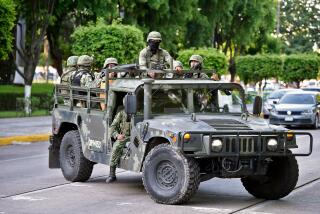Experts Hope to Identify Remains : U.S. War of 1812 Dead Found in Canada
Experts are using decaying uniform buttons and old documents to identify the skulls and bones of U.S. soldiers killed in the War of 1812 and discovered in unmarked Canadian graves.
Provided that the international team of archeologists, historians and physical anthropologists can identify the skeletons’ nationalities, remains of U.S. soldiers will be sent home and buried with full military honors.
“This is a very big deal. This is the repatriation of soldiers who fell in combat on foreign soil,” said Lt. Col. Robert Trotter, chief of the U.S. Army’s mortuary affairs branch in Washington. “They will be given the same dignified return to the United States as soldiers who fell in Vietnam.”
28 Plots Found
The $200,000 excavation also appears to be knocking down long-held theories about the height of humans and American military capability of the 1800s.
Archeologists unearthed 28 burial plots last last year at a residential development site near the Peace Bridge linking Canada and Buffalo, N.Y., about a mile west of Old Fort Erie next to a wartime U.S. battery.
U.S. troops took the fort in July, 1814, and the British tried to win it back the next month. Both sides suffered heavy casualties when Americans tried to break through British lines.
Results of the inquiry, funded by the United States and Canada, are expected in June. But at least eight of the skeletons found at the site are American, said Ron Williamson, an archeologist and leader of the excavation.
Hoping for Identities
“It’s conceiveable we could put names to some of them,” he said. “We’ll be trying our damnedest to do that.”
Some clues to the soldiers’ identities are found in their bones, he said. One skull has an impacted wisdom tooth. One skeleton has bow legs, which could mean that the soldier had rickets. Another skeleton has blue bones, evidence of fluoride, which experts said could mean the man was from Sackets Harbor, N.Y.
But archeologists are pinning their hopes on more than 400 decaying uniform buttons, which may show whether a soldier was British or American and show his rank. Some U.S. Infantry and 2nd Regiment of Artillery buttons were recovered.
Several skeletons were found with only a few bone buttons, evidence that they were buried in their underwear. Many had no buttons near their feet, indicating that they wore no boots and may have gone to battle barefoot, archeologists said.
Repatriation Ceremony
A U.S. repatriation ceremony is scheduled for June 30. Trotter said that remains identified as American will be put in flag-draped caskets and buried in a U.S. cemetery with full military honors, including a 21-gun salute.
Canada’s Veterans’ Affairs Department said that no decision has been made concerning burial of remains of British soldiers or civilians. The British Embassy in Ottawa said Britain does not bring home its war dead.
“This is the first War of 1812 cemetery to be excavated, and we’re finding information such as . . . about what they were wearing that contradicts data accepted until now,” Williamson said.
Contrary to the accepted view that people in the early 1800s were much shorter than humans of today, these skeletons are “no shorter than we are,” Williamson said.
Perception Contradicted
“And there’s always been the perception that the U.S. Army in 1812 was badly organized, that they bungled the war,” he said. “But there are indications it was a well-oiled, organized affair with a good medical evacuation system.”
The team is learning much about medical techniques of the early 1800s, he added. Six skeletons had amputated limbs, and surgery had been performed on two others.
More to Read
Sign up for Essential California
The most important California stories and recommendations in your inbox every morning.
You may occasionally receive promotional content from the Los Angeles Times.





